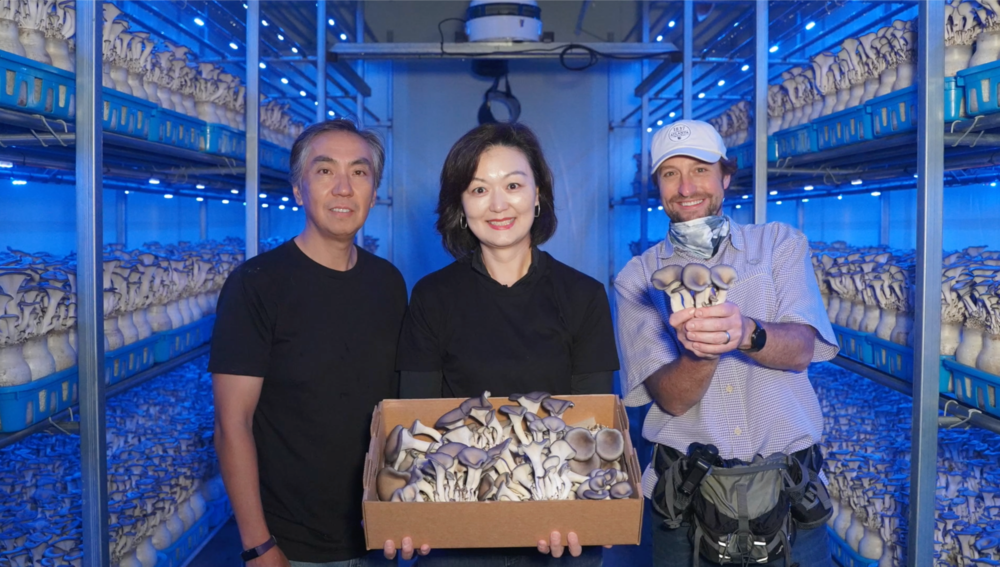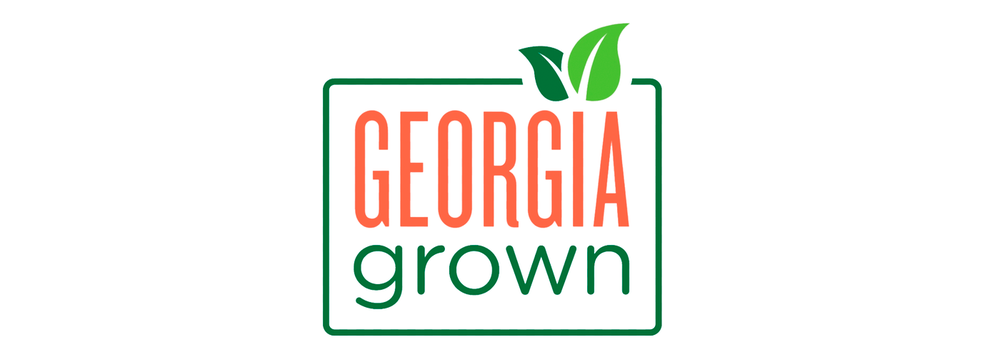
Section Branding
Header Content
A Fork in the Road Podcast: Green Box Mushrooms
Primary Content
Does your retirement plan include creating a 100% sustainable farm utilizing agricultural by-products to produce fresh gourmet mushrooms and organic compost for land farmers? It is certainly an option and it is exactly what the owners of Green Box Mushrooms in Gainesville, GA did when they left their corporate jobs.

David Zelski: Farming has come a long way in 12,000 years. Here in the future, there's ways to grow stuff that are sustainable, generative and completely indoors, and that farming of the future is happening right here in Georgia. I came from the.
Theme Song: I came from the mud, there's dirt on my hands. Strong like a tree, there's roots where I stand.
David Zelski: I'm David Zelski, and this is the Fork in the Road podcast presented by Georgia Grown and the fine folks at Georgia Public Broadcasting. Each episode we feature stories from Georgia's farmers, fishermen, merchants, artisans, chefs and others who help provide Georgia grown products to folks in the Peach State and beyond. Today, we're headed northeast to Gainesville, Ga. Right on Athens Highway, just off 985 is where we'll find John and Elizabeth Moon of Green Box Mushrooms. At Green Box Mushrooms, farmers beat the heat of the outdoors with a careful process that uses science to create ornamental, yet tasty oyster mushrooms. Their 30,000-square-foot growing facility is quite impressive. Container after container fill the space. And the blue lights aren't just relaxing. They give life to hundreds of pounds of mushrooms sprouting every day. And one of the most interesting things is that, for the Moons, farming was a later-in-life career development.
Elizabeth Moon: We started out with me and my husband looking at what do we do for our retirement. My husband and I are both computer geeks. We're from IT corporate world. And we've been doing the corporate side of business for 25 years and decided that we need to start planning for our retirement. I told him I'm not going to go ahead and dig in the dirt and be a farmer. So he looked at, from an automation perspective, a kind of a farming with more of a hydroponics side of the business or even something that doesn't require a whole lot of labor. He came with mushroom farming.
David Zelski: After a bit of research, the Moons realized they could fill a gap in the farming industry of the South.
Elizabeth Moon: We studied a little bit of the mushroom farming business itself and we noticed that pretty much the mushroom capital of the world or in the U.S. is in Pennsylvania. We decided, let's go ahead and try one up in Georgia.
David Zelski: Look out Pennsylvania. Sorry. Now, mushrooms love wet and cold in the process of mushroom farming requires a special space. And the Moons were keen to provide that.
Elizabeth Moon: We needed to build something with humidity and temperature that all can be controlled. So we built Green Box Mushrooms where we can actually have the humidity control, temperature control with air conditioning and heating into more of a sustainable business that we can use using machinery.
David Zelski: The process of making these mushrooms takes about 60 days total, and it all starts with just two ingredients. Yep, two. One of those is peanut hulls, the outermost layer of the peanut shell. As John Moon explains, to make hundreds of mushrooms a day, you need a lot of peanut shells.
John Moon: This is about 1,600-pound bag. And we use one bag a day and then we harvest that. We mix three times a week.
David Zelski: That is a lot of peanut shells. The second ingredient in the process of growing mushrooms at Green Box Mushrooms is wheat bran. The wheat bran and peanut hulls create the substrate, that's the organic mixture in which the mushrooms will grow. But first....
John Moon: This is a machine. The both peanut hulls and the wheat bran go inside. And as I explain, we initially mix without water. We call it dry mix. We mix it for 15 minutes and then start adding water, about 300 gallons of water into this tank and then mix both again hour and a half. And then this machine basically takes it out, put it into the hull and fill up each bottles.
David Zelski: The filled bottles of substrate, get placed into another machine which uses steam pressure to kill bacteria called an autoclave.
John Moon: Once we fill up this autoclave, we heat it up with boiling steam for five hours.
David Zelski: It all sounds like a fun science experiment, right? Well, there's more. After killing the bacteria in the autoclave, the mushrooms get placed into a temperature-controlled room with glowing blue UV lights.
John Moon: The bottle transports to here and get ready for the growing. It takes about 10 to 15 days to grow, to be harvested.
David Zelski: And from that point...
Elizabeth Moon: We go ahead and harvest to deliver it out to our customers and our customers, our supermarkets, to chefs, to even to retail consumers that are willing to purchase and more and in a bigger package. We also have it going out, packaged directly to the supermarkets in a small container so that they can enjoy the fresh oyster mushrooms.
David Zelski: All that mushroom harvesting leaves you with a lot of spent substrate. But don't worry, as Elizabeth explains, that substrate gets put to good use.
Elizabeth Moon: Once they're harvested out of the bottle, we take those bottles, then we scrape everything out of there and we restart back from inserting it with the substrates back in. Now, what happens to those spent substrates? We take those spent substrates and we actually sell it to our neighboring farmers so that they can use it as a fertilizer. It's a very fertile fertilizer that they put it back to the ground in order for the regular farmers to grow their greens on. So you can see that there's really nothing going to waste from our farm.
David Zelski: Though the eventual plan is to expand to different varieties, right now, Green Box Mushrooms only produces oyster mushrooms. Elizabeth explains why.
Elizabeth Moon: Oyster mushrooms, they like the bottles. They really like the bottles, how it's grown, and different type of mushrooms can be grown out of the bottle. But this is kind of the easiest one to grow out of the bottle. The reason we chose the bottle versus the bag that a lot of people see oyster mushrooms growing in is for sustainability.
David Zelski: And at Green Box Mushrooms, sustainability is the name of the game.
Elizabeth Moon: We harvest and eat and enjoy our oyster mushrooms. The spent substrates are going back to the land where nothing goes to waste. We reuse the bottles back into our circle of growing again so there's no plastic bags that we're throwing away. It's a continual cycle that we go through.
John Moon: As long as we avoid direct sunlight, this bottle can last a long time. Many contemporary factories use either plastic or this kind of reusable bottle. And as you can see, we use this bottle over and over, unlike plastic as a one time use. So we don't make any extra waste. Trying to stay in a sustainability wise so we can keep using the bottle and then convert agri-waste into the fertilizer.
David Zelski: That kind of ingenuity and dedication to a waste-free process really grows on you. Get it? Really grows on you. Oh.
Producer Jeremy: We got it.
David Zelski: And if you'd like to tour these facilities and get up close and personal with these oyster mushrooms, Green Box offers a delicious option for customers willing to make the trek.
Elizabeth Moon: We have a farm tour, and you-pick farming that's going on on Saturdays. So we welcome regular consumers to come out and visit us on Saturdays for a farm tour and they're able to pick their own mushrooms. It's so easy to pick them. Just twist and there you go. And they can go ahead and harvest their own for them to take home and enjoy. So it's very fresh. You'll be actually able to pick them on Saturdays and take what you pick.
David Zelski: Letting the consumer inspect and choose their own product. Building a hands-on relationship with the stuff they feed to themselves and their customers is a time-honored tradition of small farms. The Moons understand the passion and sense of community this creates, and from seedling to harvest, everything they produce is Georgia-grown.
Elizabeth Moon: One of the best things that we pride here and Green Box Mushroom is the fact that we are, from inception to harvest, all here in Georgia. Our substrates are actually created with U.S. byproduct agricultural waste with the peanut hull and wheat bran all here from the U.S. And you saw that it was mixed in, put into the bottles and then sterilized and you have a fully grown oyster mushroom here. So our pride is the fact that we're actually able to create and incept from being born in Georgia to fully Georgia-grown. And that's the beauty of our farm. We like the fact that we don't have to import anything from different countries. It's all from U.S., born and raised right here in Georgia.
David Zelski: So if you find yourself in Northeast Georgia near Gainesville and you've got a hankering for some tasty mushrooms, stop by and pay the Moons at Green Box Mushrooms a visit. If it's a Saturday, you can take a tour of the farm and even pick your own and you'll be glad you did.
For more stories like this one, you can watch A Fork in the Road on GPB TV or any time on the GPB.org website. GPB.org/Podcasts is where you can listen to and subscribe to this podcast or download it on your favorite podcast platform.
I'm David Zelski. Thanks for listening to A Fork in the Road.
The A Fork in the Road TV show airs Saturdays at noon and Sundays at 6:30 a.m. on GPB-TV. Check your local listings for other replays throughout the week and watch all episodes anytime at GPB.org/ForkintheRoad. Please download and subscribe to the Fork in the Road podcast at GPB.org/ForkintheRoadpodcast or on your favorite podcast platform as well.







